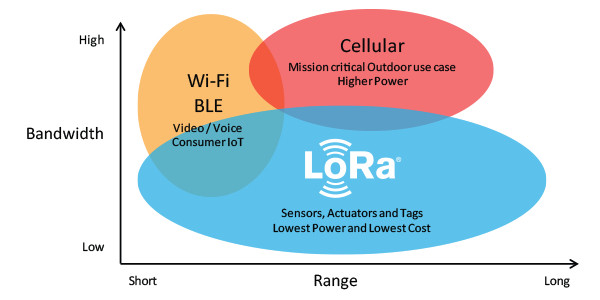IoT Wireless Communication: The Core of Industrial IoT Connectivity
Insights | 08-10-2024 | By Gary Elinoff
Cellular IoT. Image source: Researchgate
Key Takeaways about Title
- There are multiple methodologies that can be used to affect IIoT connectivity.
- These methodologies vary in power requirements, range, cost, and maturity.
- Users considering cellular-based technologies need to be aware of spectrum allocation within the countries they plan on deploying.
Introduction
We live in a world of electronic sensors that are marvellously effective, cheap, and power-stingy. There are sensors that can detect and measure light, heat, humidity, vibration – and the list goes on. An array of sensors posted around a multi-million dollar piece of capital equipment on a factory floor could convey an invaluable picture of the device’s efficiency or need for maintenance, as described in Electropage’s article The IIoT Augments the Power of Data Analytics.
However, devices to be monitored by IIoT are often mobile, and in any case, wired connections are usually impractical. But how to transmit that wealth of information, perhaps to local facility management or to analytical engines located on servers thousands of miles away?
In this article, we’ll be discussing some of the wireless communication methodologies used to move the information gleaned by the sensors, making the wireless IIoT a reality. As the reader will see, the different approaches offer varying bits per second transmission capabilities, power requirements and each has different applications that they are best suited for.
I believe it’ll be useful to mention that while the term IIoT is generally used to describe professional applications and IoT usually applies to consumer uses, the terms are often used interchangeably.
LoRa
LoRa (stands for Long Range) is a low power, low bit rate bi-direction communication standard. Maximum bandwidth is about 50 kbits/second, and it is very useful for battery powered devices where low power consumption is an important consideration.
LoRa operates on ISM (Industrial, Scientific Medical) bands, whose range of frequencies center on about 0.9 GHz. These frequencies allow for communication over distances of up to 10 or 15km, and they also exhibit better penetration through obstacles than typical 2.4 GHz cellular frequencies.
The LoRa Standard is administered by the LoRa Alliance, with Semtech serving as a founding member. The LoRa standard is sanctioned by the International Telecommunication Union (ITU), reference ITU-T Y.4480.

LoRa Compared to Wi-Fi and cellular communication. Image source: Semtech
As the picture above illustrates, LoRa has a longer operating range than Wi-Fi and Cellular. Possible data bandwidths are limited, but in many use cases, that isn’t an issue. Another advantage here is that LoRa communication requires very low power, calling for smaller, lighter power sources that will seldom require recharging or replacement.
Zigbee
Zigbee is another low-power technology. It can support bandwidths of up to 250 kbits/second when operating on 2.4 GHz bands and up to 20 kbits/second on ISM bands. It has a very short range, perhaps 10 to 100 meters. Those ranges can be expanded through mesh networking, whereby each Zigbee node can “speak” to any other node within range.
What this means in practice is that if a node’s signal can’t reach the central point, it can relay its message to an adjacent node within its range. If this node can’t reach the central point, it relays the message to yet another point. The cycle continues until the original message reaches its destination. This central point may or may not connect to the internet.
Zigbee’s main strength is that because of its low range and low data capacity, each Zigbee node requires very little power.
Zigbee standards are set by the Connectivity Standards Alliance (CSA). As is the case with the previously described LoRa alliance, adhering to CSA standards ensures that any new manufacturer’s device can be used in any established network that also conforms to the standard.
LoRa and Zigbee Compared
As described by Tektelic[1], “LoRaWAN® is good at long-range communication, supports thousands of devices, and is perfect for applications like smart agriculture and asset tracking. Zigbee is designed for low-power applications and is commonly used in home automation and industrial monitoring. LoRaWAN® has a longer transmission distance, while Zigbee offers higher data rates.”
Detailed Advantages and Disadvantages
LoRa
- Longer range
- Less power
- Spread spectrum technology guards against interference
But ……...
- Smaller data bandwidth
- The use of unlicensed radio networks opens the possibility of signal interference
Zigbee
- Better security due to the use of AES-128 encryption
- Lower Latency
- A large number of network nodes is possible
But ……...
- Generally, it works well only in indoor environments.
Use Cases for LoRa and Zigbee
This listing is by no means all-inclusive. Some applications, such as industrial monitoring, might be served by either technology, depending on specific circumstances.
LoRa is suited for Agriculture, Industry/Factory, Retail Monitoring and Control, Logistics and Intelligent fire protection.
Zigbee is best applied to Smart Homes, Building Automation, and Medical Data Collection.
NB-IoT
The Narrow Band Internet of Things (NB-IoT) connects remote devices that must be monitored and controlled. As described by u-blox, “It is “a cellular technology specializing in communication between “things” that require small amounts of data over long periods in hard-to-reach places[2].
NB-IoT is optimized to handle small amounts of infrequent two-way data. NB-IoT devices feature very low power consumption and are inexpensive. Because of the relatively low transmission frequencies, they can provide excellent coverage within buildings and underground. “Using other cellular air interfaces for a typical NB-IoT application would be too expensive, as NB-IoT applications don’t need all their capabilities.”[2]
NB-IoT for GSM and LTE Bands. Image source: Researchgate
As illustrated above, NB-IoT operates on a licensed spectrum, making it secure and reliable. As a cellular technology, if the NB-IoT node moves out of range of one cell tower, it can be picked up by the next without a dropped connection, just as in the case of consumer smartphones.
NB-IoT Use Cases
An extremely low-power technology, a single flashlight battery can power an NB-IoT device for many years. While the allowable data rates are low, signal ranges are in the order of 10 km. And one cell can handle tens of thousands of devices. Use cases include:
- Smart Buildings
- Agriculture
- Factory floor
- Health care
- Utilities
- Transportation and logistics
- Locating people and vehicles (not continuously)
5G Red_Cap
As noted in a previous Electropages article, 5G Technology: What It Means for You and Businesses, 5G isn’t much of a boon for consumers other than higher costs and the bragging rights garnered for owning the latest and greatest cellular technology. It’s as a vector for IoT communications that 5G will shine. A case in point is 5G RedCap, which means 5G reduced capacity, which is also known as 5G NR-Light.
5G Red_Cap was introduced by 3GPP, a worldwide partnership whose membership includes the world’s premier actors in the field of electronic communications who collectively define and develop telecommunication standards, including 5G.
As described by Telnor[3], “5G RedCap offers comparable latency to existing 4G LTE technologies, which is much lower than the latency in most LPWA technologies like NB-IoT. This means that 5G RedCap can support applications that require near real-time data communication, such as industrial automation and smart grid applications.”
5G Red_Cap does not encompass all the features of 5G – indeed, Red_Cap is actually an acronym for “reduced capacity”. As a result, IoT communications utilizing the technology sport lower data bandwidths, are cheaper and use less power. However, as described by Quectel[4], “RedCap delivers throughput of more than 220 Mbps downlink and over 120 Mbps uplink which, while far below full 5G’s gigabits of potential speed, is substantially more powerful than NB-IoT or Cat M1, and comparable to more advanced 4G standards – but with much-reduced latency over 4G networks, enabling use cases which rely on near real-time data communication.”
Red_Cap vs LTE
- Higher peak data rates
- Smaller device sizes
- Lower Latency
- Lower Power consumption
- Better positioning
Red_Cap will allow users to more quickly take advantage of important subsets of 5G capabilities without incurring all of the costs entailed in full 5G adaptation, as described in this Ericsson Video.
As described in the video, use cases include:
- Medical wearables (150/50 Mbps Download/Upload), with very precise patient locationing in case of emergency
- Video surveillance with <200 ms latency with 50Mbps uplink.
- Industry wireless sensors with <100ms latency with very long battery life
Challenges and Opportunities
Cellular technologies such as NB-IoT and Redcap are attractive choices. Worldwide, LTE is fairly well defined but 5G is a work in progress, so organizations considering RedCap need to be aware of the standards in the national areas that they intend to operate in.
Readers will note that the use cases for the four technologies that we speak of here exhibit significant overlap. In addition, while people talk about 6G, it is important to realize that 5G as a standard is still evolving, so what’s not practical today may well be doable in a few months time.
Sites and devices being monitored are now generating enormous amounts of data, and the costs of transmitting that data over the internet are rising. For that reason, it behoves system designers to do as many data analyses as possible locally via a process known as Edge Computing and not rely exclusively on analytical engines located thousands of miles away.
Wrapping Up
Cheap, efficient sensors that require very little power are now readily available. These devices can report on a wide variety of information that can be useful in a great range of consumer, industrial, medical and military situations. An important use for these sensors and the information that they retrieve is that they eliminate the need for a human on site to note, record and transmit that information.
In some cases, wired connections between these sensors and a local control center will be all that’s needed. But more often, the digital information gleaned from these sensors must be transmitted to analytical engines located thousands of miles away. In any case, wired connections make the reorganization of facility space a real problem.
This is where the IoT comes in. The IoT also eliminates the need for a wired connection, which would render use cases such as inventory control, transportation and health care impossible.
Zigbee and LoRa standards are controlled by well-established international organizations. NB-IoT is largely based on LTE, which is a mature standard.
Redcap is based on 5G, an evolving standard. Contrary to popular opinion, 5G hasn’t really changed much for consumers, but on the other hand, it seems to be the way the telecom world is heading. Designers who are choosing to adapt to this exciting new choice need to do their homework because being a pioneer can be risky.
References:
- Comparison Of LoRaWAN And Zigbee Networks. tektelic.com
- Narrowband IoT (NB-IoT). u-blox.com
- 5G RedCap for IoT: The Perfect Balance of 5G Capabilities. iot.telenor.com
- Is 5G RedCap the right fit for your IoT connectivity needs? quectel.com
Glossary of Terms
- Mesh Networking. Each node in a mesh network also acts as a repeater, connecting to an adjacent node and relaying the message over a distance.
- LPWAN. Low power wide area network. Used to connect low bandwidth battery-powered devices over relatively long distances.



